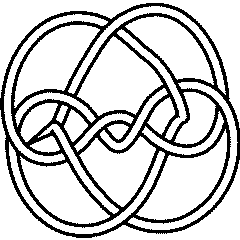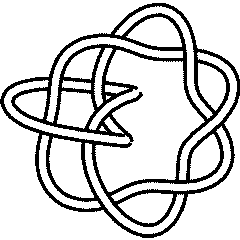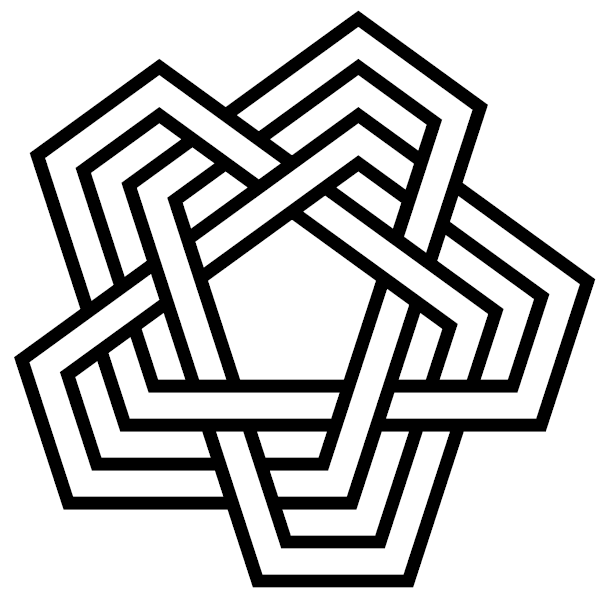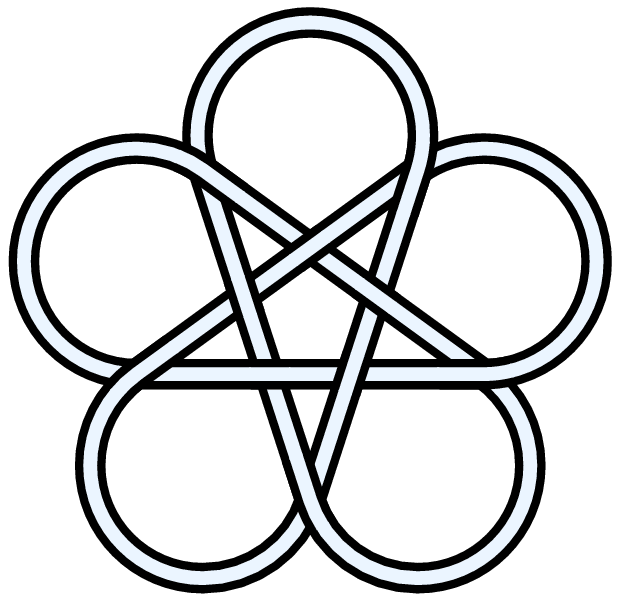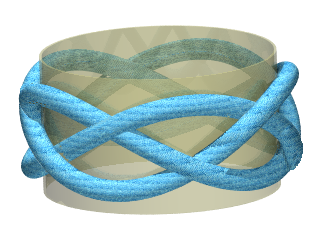10 123
|
|
|
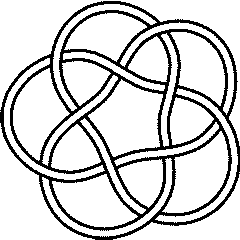
|
Visit 10 123's page at the Knot Server (KnotPlot driven, includes 3D interactive images!)
Visit 10 123's page at Knotilus! Visit 10 123's page at the original Knot Atlas! |
10_123 can be depicted with five-fold rotational symmetry (like 5 1). |
Knot presentations
| Planar diagram presentation | X8291 X10,3,11,4 X12,6,13,5 X4,18,5,17 X18,11,19,12 X2,15,3,16 X16,10,17,9 X20,14,1,13 X14,7,15,8 X6,19,7,20 |
| Gauss code | 1, -6, 2, -4, 3, -10, 9, -1, 7, -2, 5, -3, 8, -9, 6, -7, 4, -5, 10, -8 |
| Dowker-Thistlethwaite code | 8 10 12 14 16 18 20 2 4 6 |
| Conway Notation | [10*] |
Three dimensional invariants
|
Four dimensional invariants
|
Polynomial invariants
A1 Invariants.
| Weight | Invariant |
|---|---|
| 1 | |
| 2 | |
| 3 | |
| 5 | |
| 6 |
A2 Invariants.
| Weight | Invariant |
|---|---|
| 1,0 | |
| 1,1 | |
| 2,0 |
A3 Invariants.
| Weight | Invariant |
|---|---|
| 0,1,0 | |
| 1,0,0 | |
| 1,0,1 |
A4 Invariants.
| Weight | Invariant |
|---|---|
| 0,1,0,0 | |
| 1,0,0,0 |
B2 Invariants.
| Weight | Invariant |
|---|---|
| 0,1 | |
| 1,0 |
D4 Invariants.
| Weight | Invariant |
|---|---|
| 1,0,0,0 |
G2 Invariants.
| Weight | Invariant |
|---|---|
| 1,0 |
.
KnotTheory`, as shown in the (simulated) Mathematica session below. Your input (in red) is realistic; all else should have the same content as in a real mathematica session, but with different formatting. This Mathematica session is also available (albeit only for the knot 5_2) as the notebook PolynomialInvariantsSession.nb.
(The path below may be different on your system, and possibly also the KnotTheory` date)
In[1]:=
|
AppendTo[$Path, "C:/drorbn/projects/KAtlas/"];
<< KnotTheory`
|
Loading KnotTheory` version of August 31, 2006, 11:25:27.5625.
|
In[3]:=
|
K = Knot["10 123"];
|
In[4]:=
|
Alexander[K][t]
|
KnotTheory::loading: Loading precomputed data in PD4Knots`.
|
Out[4]=
|
In[5]:=
|
Conway[K][z]
|
Out[5]=
|
In[6]:=
|
Alexander[K, 2][t]
|
KnotTheory::credits: The program Alexander[K, r] to compute Alexander ideals was written by Jana Archibald at the University of Toronto in the summer of 2005.
|
Out[6]=
|
In[7]:=
|
{KnotDet[K], KnotSignature[K]}
|
Out[7]=
|
{ 121, 0 } |
In[8]:=
|
Jones[K][q]
|
KnotTheory::loading: Loading precomputed data in Jones4Knots`.
|
Out[8]=
|
In[9]:=
|
HOMFLYPT[K][a, z]
|
KnotTheory::credits: The HOMFLYPT program was written by Scott Morrison.
|
Out[9]=
|
In[10]:=
|
Kauffman[K][a, z]
|
KnotTheory::loading: Loading precomputed data in Kauffman4Knots`.
|
Out[10]=
|
Vassiliev invariants
| V2 and V3: | (-2, 0) |
| V2,1 through V6,9: |
|
V2,1 through V6,9 were provided by Petr Dunin-Barkowski <barkovs@itep.ru>, Andrey Smirnov <asmirnov@itep.ru>, and Alexei Sleptsov <sleptsov@itep.ru> and uploaded on October 2010 by User:Drorbn. Note that they are normalized differently than V2 and V3.
Khovanov Homology
The coefficients of the monomials are shown, along with their alternating sums (fixed , alternation over ). The squares with yellow highlighting are those on the "critical diagonals", where or , where 0 is the signature of 10 123. Nonzero entries off the critical diagonals (if any exist) are highlighted in red.
|
-5 | -4 | -3 | -2 | -1 | 0 | 1 | 2 | 3 | 4 | 5 | χ | |||||||||
| 11 | 1 | -1 | |||||||||||||||||||
| 9 | 4 | 4 | |||||||||||||||||||
| 7 | 6 | 1 | -5 | ||||||||||||||||||
| 5 | 9 | 4 | 5 | ||||||||||||||||||
| 3 | 10 | 6 | -4 | ||||||||||||||||||
| 1 | 11 | 9 | 2 | ||||||||||||||||||
| -1 | 9 | 11 | 2 | ||||||||||||||||||
| -3 | 6 | 10 | -4 | ||||||||||||||||||
| -5 | 4 | 9 | 5 | ||||||||||||||||||
| -7 | 1 | 6 | -5 | ||||||||||||||||||
| -9 | 4 | 4 | |||||||||||||||||||
| -11 | 1 | -1 |
Computer Talk
Much of the above data can be recomputed by Mathematica using the package KnotTheory`. See A Sample KnotTheory` Session.
In[1]:= |
<< KnotTheory` |
Loading KnotTheory` (version of August 17, 2005, 14:44:34)... | |
In[2]:= | Crossings[Knot[10, 123]] |
Out[2]= | 10 |
In[3]:= | PD[Knot[10, 123]] |
Out[3]= | PD[X[8, 2, 9, 1], X[10, 3, 11, 4], X[12, 6, 13, 5], X[4, 18, 5, 17],X[18, 11, 19, 12], X[2, 15, 3, 16], X[16, 10, 17, 9],X[20, 14, 1, 13], X[14, 7, 15, 8], X[6, 19, 7, 20]] |
In[4]:= | GaussCode[Knot[10, 123]] |
Out[4]= | GaussCode[1, -6, 2, -4, 3, -10, 9, -1, 7, -2, 5, -3, 8, -9, 6, -7, 4, -5, 10, -8] |
In[5]:= | BR[Knot[10, 123]] |
Out[5]= | BR[3, {-1, 2, -1, 2, -1, 2, -1, 2, -1, 2}] |
In[6]:= | alex = Alexander[Knot[10, 123]][t] |
Out[6]= | -4 6 15 24 2 3 4 |
In[7]:= | Conway[Knot[10, 123]][z] |
Out[7]= | 2 4 6 8 1 - 2 z - z + 2 z + z |
In[8]:= | Select[AllKnots[], (alex === Alexander[#][t])&] |
Out[8]= | {Knot[10, 123], Knot[11, Alternating, 28]} |
In[9]:= | {KnotDet[Knot[10, 123]], KnotSignature[Knot[10, 123]]} |
Out[9]= | {121, 0} |
In[10]:= | J=Jones[Knot[10, 123]][q] |
Out[10]= | -5 5 10 15 19 2 3 4 5 |
In[11]:= | Select[AllKnots[], (J === Jones[#][q] || (J /. q-> 1/q) === Jones[#][q])&] |
Out[11]= | {Knot[10, 123]} |
In[12]:= | A2Invariant[Knot[10, 123]][q] |
Out[12]= | -14 3 2 3 3 4 2 4 8 10 |
In[13]:= | Kauffman[Knot[10, 123]][a, z] |
Out[13]= | 2 3 32 2 2 z 2 6 z 2 2 5 z 21 z |
In[14]:= | {Vassiliev[2][Knot[10, 123]], Vassiliev[3][Knot[10, 123]]} |
Out[14]= | {0, 0} |
In[15]:= | Kh[Knot[10, 123]][q, t] |
Out[15]= | 11 1 4 1 6 4 9 6 |
